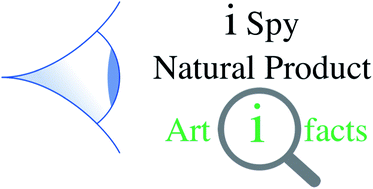当前位置:
X-MOL 学术
›
Nat. Prod. Rep.
›
论文详情
Our official English website, www.x-mol.net, welcomes your
feedback! (Note: you will need to create a separate account there.)
Extracting value: mechanistic insights into the formation of natural product artifacts - case studies in marine natural products.
Natural Product Reports ( IF 10.2 ) Pub Date : 2019-05-02 , DOI: 10.1039/c9np00013e Robert J Capon 1
Natural Product Reports ( IF 10.2 ) Pub Date : 2019-05-02 , DOI: 10.1039/c9np00013e Robert J Capon 1
Affiliation

|
Covering: up to the end of 2018Natural selection relentlessly drives the evolution of natural products, favoring those that enhance the survival of species. During this evolutionary journey, some natural products acquire heightened chemical reactivity towards environmental stimuli, most likely benefiting host species through more agile ecological responses, leading to superior survival outcomes (i.e., more potent and faster acting toxins and chemical defences, infection control, and intra/inter species chemical communication). Although knowledge of natural products informs our understanding of the living world, inspiring new medicines, agrochemicals and scientific tools, the study of chemically reactive natural products can be particularly informative, albeit quite challenging. For example, such natural products are often prone to facile transformations during handling, yielding new "un-natural" products commonly referred to as artifacts. These transformations can be induced by many stimuli, including modest changes in pH or temperature, or exposure to light or air (i.e., oxygen), or even common organic solvents or chromatography media. Sadly, in the race to explore and report on new natural products, knowledge of the relationship between chemically reactive natural products and their artifacts is not always recognised, documented or valued. This review seeks to recalibrate and encourage a greater awareness of the relationship between natural products and artifacts, by examining case studies in the field of marine natural products chemistry (i.e., natural products and associated artifacts from marine invertebrates and algae, and marine-derived microbes). While every effort has been made to provide a comprehensive coverage up to early 2019, any omissions are inadvertent not deliberate. Structured around the types of chemical transformations that can deliver artifacts, and the functional groups involved, the review concludes with observations on how to regulate, detect, rationalise and even exploit artifacts, going forward.
中文翻译:

提取价值:对天然产物人工产物形成机理的见解-海洋天然产物的案例研究。
涵盖期:到2018年底,自然选择将无情地推动天然产物的进化,而偏向那些能提高物种生存能力的物质。在这一进化过程中,某些天然产物对环境刺激具有增强的化学反应性,最有可能通过更敏捷的生态反应使宿主物种受益,从而带来卓越的生存结果(即,更有效,更快速地发挥作用的毒素和化学防御,感染控制以及体内毒性)。 /种间化学通讯)。尽管对天然产物的了解有助于我们对生活世界的理解,启发了新药,农用化学品和科学工具,但是对化学反应性天然产物的研究尽管具有很大的挑战性,但却可以提供特别丰富的信息。例如,这样的天然产物在处理过程中常常易于转化,产生通常被称为人工制品的新的“非天然”产物。这些转化可以通过许多刺激来诱导,包括pH值或温度的适度变化,暴露于光或空气(即氧气)或什至是常见的有机溶剂或色谱介质中。可悲的是,在探索和报告新的天然产物的竞赛中,化学反应性天然产物与其人工制品之间关系的知识并不总是被认可,记录或重视。通过审查海洋天然产物化学领域的案例研究(即,海洋无脊椎动物和藻类以及海洋来源的微生物的天然产物和相关人工制品)。尽管已尽一切努力在2019年初之前提供全面的报道,但任何疏忽都是无意间而不是故意的。围绕可传递伪影的化学转化类型以及所涉及的功能组构建的综述总结了对如何调节,检测,合理化甚至利用伪影的观察,并展望了未来。
更新日期:2020-02-13
中文翻译:

提取价值:对天然产物人工产物形成机理的见解-海洋天然产物的案例研究。
涵盖期:到2018年底,自然选择将无情地推动天然产物的进化,而偏向那些能提高物种生存能力的物质。在这一进化过程中,某些天然产物对环境刺激具有增强的化学反应性,最有可能通过更敏捷的生态反应使宿主物种受益,从而带来卓越的生存结果(即,更有效,更快速地发挥作用的毒素和化学防御,感染控制以及体内毒性)。 /种间化学通讯)。尽管对天然产物的了解有助于我们对生活世界的理解,启发了新药,农用化学品和科学工具,但是对化学反应性天然产物的研究尽管具有很大的挑战性,但却可以提供特别丰富的信息。例如,这样的天然产物在处理过程中常常易于转化,产生通常被称为人工制品的新的“非天然”产物。这些转化可以通过许多刺激来诱导,包括pH值或温度的适度变化,暴露于光或空气(即氧气)或什至是常见的有机溶剂或色谱介质中。可悲的是,在探索和报告新的天然产物的竞赛中,化学反应性天然产物与其人工制品之间关系的知识并不总是被认可,记录或重视。通过审查海洋天然产物化学领域的案例研究(即,海洋无脊椎动物和藻类以及海洋来源的微生物的天然产物和相关人工制品)。尽管已尽一切努力在2019年初之前提供全面的报道,但任何疏忽都是无意间而不是故意的。围绕可传递伪影的化学转化类型以及所涉及的功能组构建的综述总结了对如何调节,检测,合理化甚至利用伪影的观察,并展望了未来。











































 京公网安备 11010802027423号
京公网安备 11010802027423号